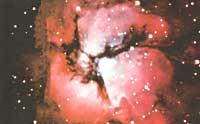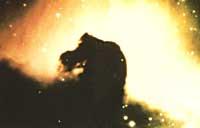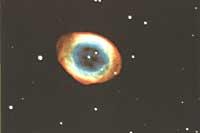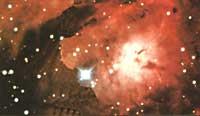Interstellar molecules
1990/06/01 Unzueta, Elias Iturria: Elhuyar aldizkaria
The most abundant element in the universe is hydrogen. In addition, there are other synthesized elements inside the stars and sent into space by supernovae when exploding. This matter cools very quickly condensing it. According to the evolutionary theory of stars, due to gravitation and gradually, these clouds of dust and gas create new stars slightly different from the previous ones.
This process is very long on the temporal scale of the human being. Therefore, to know and understand the evolution of stars and entire galaxies, the knowledge of particles and interstellar gas and their dynamics will be absolutely necessary. No wonder, therefore, the great momentum that this issue has had in recent years.
Interstellar medium

The interstellar medium consists mainly of gas and dust. In a normal spatial volume the ratio between the two is one percent. It is evident, on the other hand, that these clouds of gas and dust do not spread evenly in space, being much denser in the special parts of the galaxy, as in the spiral arms.
The total mass of milk gas is one billion times greater than that of our sun, but it represents only 1% of the mass of the entire galaxy. These proportions depend, among other things, on the type of galaxy. In elliptical galaxies, with 10-4%, irregular galaxies can range from 20% to 50%.
The normal measurement of cosmic dust grains is 10-4-10-5 cm, approximately equal to the wavelength of visible light. Dust grains absorb light forming clouds or dark nebulae in the sky. Therefore, we cannot see from the earth the discreet center of our galaxy.
Finally, it should be noted that these interstellar dust grains originate from low-energy shocks between atoms and molecules in space. Therefore, the chemical composition of dust and gas will be similar.
The presence of gas in the stars was demonstrated at the beginning of this century when the absorption bands of ionized calcium were analyzed. Being these absorption bands initially obtained in spectra of distant hot stars, it was argued that calcium was inside the stars. But more accurate measurements showed that calcium should be between the star and the observer. This use (i.e., the measurement of light spectrum absorption from stars along this path has been the best way to analyze the interstellar medium.
Interstellar gas consists of ions on the HII sides and atoms and molecules on the HI sides. The difference between both sides is whether or not to have a nearby energy source, usually a star. The irradiations of this energy source will excite the elements to the ionic state, keeping them stable in it. Therefore the clouds on the HII sides do not appear dark or luminous. Several nebulae witness this, as they have a strong electromagnetic emission.
Spatial molecules

The most abundant element of the universe is hydrogen. Because of the nuclear reactions that occur inside the stars, all other elements come from hydrogen. The dynamics of the evolution of the stars make novas and supernovas send to space a lot of materials within the star. With this matter we have formed the interstellar gas, the new stars, the planets and us.
It is not strange, therefore, that the interstellar medium is formed mainly by hydrogen. But there are other heavier elements that we will immediately analyze.
By 1920, astronomers working on the optical spectra of the stars discovered that in the spectra of some stars there were very wide absorption bands. In addition, the farther away the stars analyzed, the more prominent these broad bands were. As an immediate consequence, these absorption bands are accused of matter between star and observer.
Studies of these absorption bands quickly complicated theories about interstellar dust. They were initially considered grains of pure graphite and then graphite grains surrounded by ice, followed by carbon, diamond, silicon and finally porphyrin. Although the latter was presented as a possibility at the 1970 International Astronomical Commission Congress, there are many problems in getting a valid test.
F. Adams, in 1937, managed to distinguish narrow bands characteristics in very close star spectra. This time they were not wide bands caused by dust, but absorptions of special molecules. The CH, CH + and CN of these molecules were radical. On the other hand, being such thin bands, the low temperature of these gas clouds stands out.
In the same line, the analysis of the absorption bands of the CN radical presents the electronic state. In this way the rotating energy of these molecules becomes measurable, between 3 and 5 kelvin. Despite not having paid much attention to this result in those years, both the prestigious Gamow in 1941, and especially the studies conducted by Penzias and Wilson in 1965 (according to the Big-Bang theory, which must be the temperature of the current universe), we now know its value and precision.
At these low temperatures the optical spectroscope has few possibilities, since the emission of molecules will occur at a lower frequency. All this opened the door to radio astronomy, the most valuable method to study the interstellar medium.
The first victory of radio astronomy was that Edward Purcell, in 1951, found neutral hydrogen (HI zones). It was also shown that our galaxy was a spiral.
After this discovery, several researchers began to look for other alternatives. Being oxygen (the most abundant element behind hydrogen and helium), they tried to find the traces of the radical OH. In 1962, Weinreb and Barrett found this radical with a 1650 MHz frequency detector.
The spectrum of radical hydroxyl presented a series of particularities: four very narrow lines and usually four measures in absorption, but occasionally one is measured in emission. According to this, a quantum theory has been developed that considers OH radicals as a natural maser.
As for its abundance, radical hydroxyl is 10 7 times lower than neutral hydrogen.
In 1968, F.P. Townes and auxiliaries found ammonia (NH 3) in the center direction of the galaxy and 23.700 MHz. This emission is due to the phenomenon of investment in ammonia. Soon after and 22.200 MHz water was found (H 2 O). Since the water absorption bands have similar characteristics to the BED bands, it can be concluded that water is also a powerful maser in the interstellar medium.

Although these discoveries are theoretically important, it seemed that the ability to find other molecules was weak. However, when in 1969 it was discovered as abundant as formaldehyde (HCHO) hydroxyl (OH) and extended throughout the galaxy, the view of the previously accepted interstellar medium changed radically. The importance of this discovery increased when formaldehyde was seen to be colder than its surroundings. No explanation of this anti-investment has yet been found.
It was immediately recognized that the complexity of the molecules in space could be greater (two or more heavy atoms could be located in each molecule). The most serious problem for the detection of these molecules was the technical one, that is, the frequency windows of the measuring devices used were small.
This changed in 1970 when Bell Telephon researchers placed the meter on the 11m Kitt Peak radio telescope in Arizona, which reached 150,000 MHz. In a year they discovered more than twelve new molecules. Most of them were seen on the plane of the average galaxy, but others such as CO, HCN, CS and H 2 CO extend throughout the galaxy.
The abundance of these molecules seems to depend on their chemical complexity. While the H:OH ratio is 10 7 :1, the expected CN:HCN ratio is equal to 0.1. There is also a clear chemical separation between the molecules found, since most molecules with more than one heavy atom also have a carbon atom and some are very complex (HCONH 2 and CH 2 C 3 H, for example). As an exception we have very scarce SiO. The OCS molecule has also been found.
Between 1968 and 1971 several molecules were discovered with the Kitt Peak radio telescope in Arizona. Subsequently, despite the researchers' efforts, fewer new molecules were detected.
Later studies tried to deepen the peculiarities of the molecules found and understand the physics of high density interstellar clouds. Thus, studies of emission lines have managed to fix the density and temperature of some clouds (a structure).
Can one therefore think that most of the most abundant molecules have already been discovered and that from now on only some special molecules will be known that will be very rare? The large number of unknown lines we have in the spectra obtained so far makes us claim a negative response.
Many of these unknown lines are very robust. As an example we have a line of 89.1 GHz. Because the motive molecule was long unknown, it is called the X-Gen line.
One of the ways of identifying these lines would be to analyze in laboratory the spectra of certain special and suspicious molecules. However, it is possible that certain molecules, radicals, which may have a relatively long life in space, are so unstable in the laboratory that they may have clays.
In practice, looking for a longer life of radicals, these radicals freeze in neon or argon matrices and at the temperature of liquid helium. At such low temperatures, we cannot analyze the rotation spectra. On the contrary, the hyperthin structure of spin molecules and medium ones can be studied. With this data, molecular physicists can predict rotation bands, allowing further comparison with unknown spectra.
Following this path, in 1973 the Goddard Institute for Space Studies analyzed four unknown lines discovered at 87 GHz. They were finally found to be ethylene (<C CH).
Subsequently, a more important step was taken in these studies, identifying the emission of an unstable radical at the temperature of liquid helium. This radical is the radical cation NH + 2. Its absorption bands are three lines that appear at 93.1 GHz.
One of the researchers at Columbia University in New York conducted an ab initio estimate on the structure of NH + 2. Based on the theoretical calculation of the energies and distances of the nuclei and electrons in this calculation, we obtain the quantum rotation constant of the molecule, the hyperfine structure, etc. The key is in the good sense of the approximations necessary to obtain results. However, the error of current calculations can be reduced considerably from 1%.
Thanks to this laborious work, in addition to the cations NH + 2 radicals, CH + and HCO + have been identified. The latter is the incognito X-Gen mentioned above.
Space: very special chemical laboratory

For many years the interstellar medium has been considered a low-density gas formed by atoms. In this gas the atoms occasionally had some shock. Depending on the speed and direction these collisions would occasionally be effective, that is, occasionally a stable molecule would form. According to this model, the molecules of space could be expected to be very simple, with two or three atoms.
Studies led to the identification of molecules with four heavy atoms, forcing this model to be completely modified. This heterogeneous catalyst, which needed a catalyst for the mechanism needed to form these molecules, is formed by dust grains. It is assumed that these grains capture heavy atoms facilitating chemical interactions with each other. Then, for example, the molecules synthesized by heating can be sublimated by the formation of free radicals and molecules in a gaseous state.
In the same line, the most interesting theory to explain the synthesis of interstellar molecules is the one exposed by the chemist Klemperer in 1970. According to this, the key of the reactions is in the cation CH + radical. The synthesis reactions would be:

C 2 and CH+ are found in the atmosphere of the stars. In the interstellar zone CN, CO and CS, as we know.
In another branch of the explorations, several researchers have tried to measure the isotopic relationships of the different atoms and compare them with those we have in the soil or in the solar system. For example, the first results were obtained with the most stable isotopes of carbon and oxygen (13 C and 18 O) of the most numerous molecules (CO, HCN and OH), with relationships 12 C/ 13 C and 16 O/ 18 O identical to those of the soil. However, many of the results obtained with other much rarer isotopes (2H, 15N, 17O, 33S and 34S) have shown a clear discrepancy with land relations. In the line of the chemical evolution of the galaxy we have clear the importance of these results (although today, especially in the case of deuterium, isotopic fractionations are increasingly accepted in chemical reactions).
Finally we will enter into the concerns of bioastronomers, even if very briefly. We have seen that in the interstellar environment predominate H, C, O and N. There are also special organic molecules. Many of them are recognized as precursors of life (at least in the trials performed by Berthelot with C and H 2 in his “cosmic egg”).
In these essays Urey, Sagan and Miller also deepened. In a mixture of methane (CH 4), ammonia (NH 3), water (H 2 O) and hydrogen (H 2) electric sparks were produced. Among the molecules obtained are sugars, amino acids and aromatic chains much more complex HCN, CN 2, HCO, CH 3, CHO, C 2 H 2, C 2 H 6 and much more complex. Although the interstellar medium is so strange, many of these fragile organic molecules have been found in this medium.
Despite the complex and little studied relationship between the generation of life on Earth and the interstellar medium, there are also daring ones who argue that the first critical stage for life (synthesis of essential amino acids for life) could occur in the turbulent planetary cloud.
We got a general idea about the complexity of the interstellar environment. We have realized the advantages of understanding this environment. It is a perfect way to know the evolution of galaxies and the whole universe. There are also people who go further, that is, who try to relate the interstellar medium to life on Earth. We can be sure that in the coming years astronomy will give many novelties.

Gai honi buruzko eduki gehiago
Elhuyarrek garatutako teknologia





